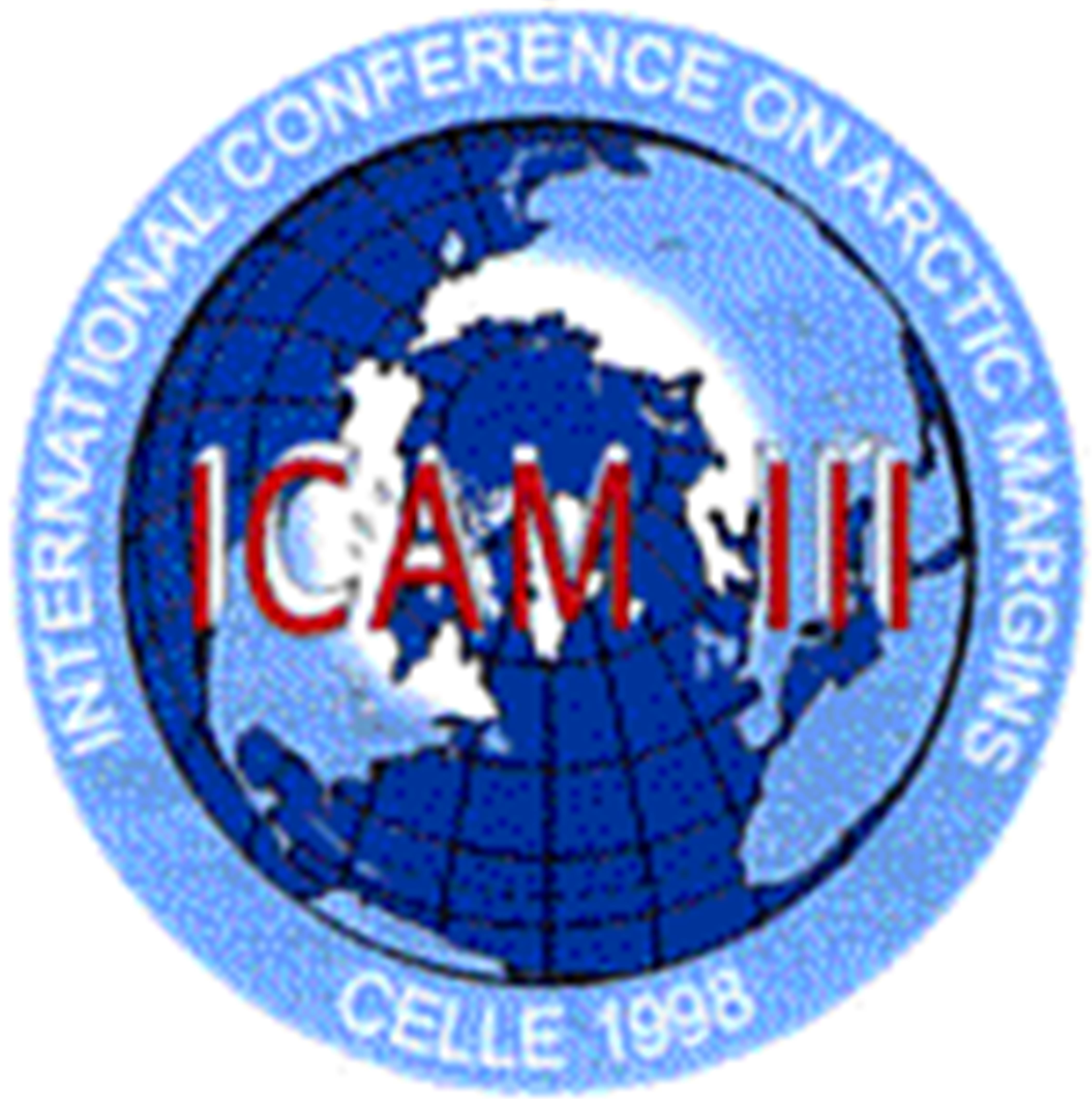
SUMMARY OF CONFERENCE
(Celle, Germany, October 12-16, 1998)
Steering Committee
- Franz Tessensohn (BGR, Hannover, Germany)
- Georg Kleinschmidt (Deutsche Polargesellschaft, Germany)
- Dieter Fhatterer (AWI, Bremerhaven, Germany)
- Dennis Thurston (BOEM, Anchorage, Alaska, USA)
- Kirill Simakov (RAS, Magadan, Russia)
Organizing Institutions
- Bundesanstalt fh r Geowissenschaften und Rohstoffe (BGR)
- Federal Institute for Geosciences and Natural Resources Hannover
- Deutsche Gesellschaft fh r Polarforschung
- German Society for Polar Research Bremerhaven
- Alfred-Wegener-Institute fh r Polar-und Meeresforschung
- Alfred Wegener Institute for Polar and Marine Research (AWI), Bremerhaven
Local Organization
Bundesanstalt fh r Geowissenschaften und Rohstoff
Stilleweg 2, D-30655 Hannover, Germany
Phone: ++49-511-643 3137 Fax: ++49-511-643 3663
e-mail: geo.polar@bgr.de
- 200 participants from 14 countries
- 15 Technical Sessions
- 142 oral presentations and 70 posters
- Hosted by the Federal Institute for Geosciences and Natural Resources (BGR), the German Society for Polar Research, and the Alfred Wegener Institute for Polar and Marine Research
- Supported by the Russian Academy of Sciences, the University of Alaska Geophysical Institute, and BOEM.
- 220 Abstracts received
- 2 Proceedings Volumes with 67 papers published in AWI’s “Polarforschung”
General Sessions
See the Technical Schedule
- Theme 1: Volcanic Provinces around the Eurasian Basin: Interplay with Tectonism
- Theme 2: Aerogeophysics on the Eurasian Shelves: Signatures and Interpretations
- Theme 3: Plate Boundary Problems in the Laptev Sea Area
- Theme 4: The Lomonosov Ridge: History, Boundaries, Function
- Theme 5: The Barents Shelf and the Eastern Greenland Margin: A Comparison
- Theme 6: Eurekan Tectonism in Canada, North Greenland, West Spitsbergen: Fold Belts Adjacent to Extensional Ocean Basins
- Theme 7: Problems of the Caledonian / Ellesmerian Junction
- Theme 8: Polar Urals, Novaja Zemlya and Taimyr: The Northern Connection of the Uralides
- Theme 9: Hydrocarbon Potential of the Eurasian Margins: Geological and Tectonic Factors
- Theme 10: Metallogenic Provinces in the Circum-Arctic Region
- Theme 11: Cenozoic Sedimentary Archives of the Eurasian Marginal Seas: Sampling, Coring and Drilling Programmes
- Theme 12: Gashydrates and Permafrost, Onshore and Offshore
- Theme 13: The Amerasian Basin and Margins: New Developments and Results
- Theme 14: Circum-Arctic Margins: the Search for Fits and Matches
- Theme 15: Geodynamics of the Arctic Region
Plenary Presentations
- Eurasian Arctic Margin: Earth Science Problems and Research Challenges, I.S. Gramberg, G. Grikurov, V. Ivanov, Eu. Korago, M. Kos'ko, A. Piskarev, Yu. Pogrebitsky & O. Suprunenko
- The Eurasian Basin, T Y. Kristoffersen
Poster sessions covering the above general session topics.
The Arctic region with its deep oceanic basins, its system of narrow ridges and wide and extensive continental margins, is one of the most exciting areas for geological investigations. The oceanic basins are 3000-4000 m deep areas underlain by oceanic crust. The Eurasian Basin as the northernmost part of the Atlantic spreading system and the Amerasian Basin as a rather enigmatic rounded deep hole are surrounded by continents without clearly detectable mid-oceanic ridge and without clear connection to any other major spreading system.
The NansenlGakkel Ridge is a very slow spreading ridge, the slowest section on the entire Atlantic mid-oceanic ridge. The Lomonosov Ridge forms a narrow band of continental crust, obviously split off by spreading processes from the Eurasian shelf between Spitsbergen and the Laptev Sea. The ill-defined enigmatic Alpha Ridge finally may be a major volcanic feature in parts of its total extension.
The continental margins around the Arctic ocean generally comprise comparatively wide shelf areas and contain most of the sedimentary record of the development of the entire region. Major tectonic structures dissect parts of the shelves and, from an Arctic viewpoint, form connections to the outside world.
These structural breaks in the shelf system are the Fram Strait between Barents shelf and Greenland and the Nares Strait between Greenland and Canada. While there is no marine passage at the Laptev Sea, where the present Atlantic mid-oceanic ridge system enters the Eurasian continental shelf in the form of a complicated mosaic of horsts and grabens, there is an overflow rather than a deep structural break at the Bering Strait passage to the Pacific. Several Mesozoic and Palaeozoic mountain belts, the Caledonides, and Uralides and the Ellesmerian and Verkhojansk belts cross the Arctic shelves to end abruptly at the shelf breaks with no obvious continuations. The shelves contain large and deep sedimentary basins with a high potential for hydro-carbon development. Together they may well be regarded as a "giant" petroleum province, although the actual production is still comparatively low.
The whole area is bearing the imprint of the last glacial period in the form of extensive permafrost, partly in submarine form, and related features such as gas hydrates, interesting both as possible energy source as well as a possible climate-influencing factor.
The ICAM conferences, initiated soon after the major political changes in Russia, try to provide a forum for the scientific discussion of all these features. The first conference was organized by a spontaneous move of a government institution and a university in Alaska and the conferences are still borne by scientists rather than being attached to a major international organization.
The Third International Conference on Arctic Margins was held in the medieval town of Celle in northern Germany from October 12-15, 1998. The emphasis of this conference was on the geodynamic evolution of the Arctic region and, in particular, on the geology and geophysics of the margins of the Eurasian Basin.
See the full meeting Summary here.
The ICAM 1998 Proceedings, edited by Norbert W. Roland of the Alfred Wegener Institute and Franz Tessensohn of German Federal Institute for Geosciences and Natural Resources, were published as two special volumes of the Journal Polarforschung (numbers 68 and 69) in 2000 and 2001 by the German Society for Polar Research and Alfred Wegener Institute for Polar and Marine Research.
Special Thanks to BOEM, Alaska Region for Hosting this Site
